How To Lose Weight on a Plant-Based Diet

Losing weight was not something I was ever “good” at. Like most I would start a diet and an extreme exercise program only to “fall off the wagon” a few weeks in. When I was able to stick something out for a few months, I’d only end up losing a few lbs. All the hard work and deprivation never seemed quite worth the 4-5 lb loss. I was perpetually frustrated and discouraged.
But then I found my way to a plant based diet and the concept of calorie density, and my life and weight began to change, and for the better!
In this blog post I’m going to explain exactly how to use calorie density and apply it to your diet for weight loss….and the best part….You won’t have to count a single calorie! But I am also going to briefly touch on when and how calorie tracking can help you in certain situations, specifically in working through a plateau.
Weight loss plateaus can be extremely frustrating and somewhat difficult to troubleshoot, so knowing when and how to use calorie tracking as a tool, can come in useful.
What is Calorie Density
Calorie density is simply the measure of energy or calories, in a given weight of food. In this blog I will be talking about calories per pound. If you are anywhere else in the world, you will use calorie density in calories per kilogram. The same principles apply.
For Example:
1 lb of broccoli has around 150 calories per/ lb. Chocolate has around 3000 calories per/ lb.

If you take a look at this calorie density chart, you’ll see that vegetables are the lowest in calorie density. You will also notice that oil is the highest in calorie density of all foods, and it’s actually best to avoid it if weight loss is what you are going for.
Interestingly, researchers found that people that ate below the 600 calorie per/ lb mark, lost weight effortlessly and were able to get into a healthy weight range. For this reason I highlighted all the foods that are 600 cal/ lb or less in green, avocados in yellow, and all the other calorie dense foods are in red so that you make sure to eliminate them or use great caution if weight loss is your goal.

But Who Cares?
So I know what you are thinking…who cares how many calories are in a pound of broccoli or in a pound of chocolate? I’m not eating a whole pound of chocolate in one sitting so why does the calorie density matter?
Here’s what researchers found….Researchers found that people generally eat the same volume of food each day, regardless of the types of food they ate. Now that doesn’t mean that I eat the same volume of food as my husband, it just means that I, Kiki, eat roughly the same volume of food each day, regardless of the types of food I eat. So according to research, It doesn’t really matter if I eat donuts all day or beans and rice all day…..I will still eat 4 lbs of food a day no matter what it is, and this is important.
Researchers found that people eat anywhere between 3-6 lbs of food a day. So I may eat around 4 lbs of food every day, and my husband may eat around 6 lbs of food every day.
The volume of food each one of us eats every day is specific to our individual biology, so I can’t expect to eat as little as one person or as much as another. My body craves its own specific amount of food and my hunger drive will make sure I get that each day.

Satiation
Satiation is driven by several components, calories, nutrients, and volume. The combination of all these components influence your satiation signals. Researchers found that even if there are enough calories and nutrients in a meal, but not enough bulk or volume, then satiation was not triggered. This is why eating a small meal replacement bar may check all the calorie and nutrient boxes, but it doesn’t check the bulk/ volume box which triggers satiation, so you are left feeling hungry and unsatisfied.

Instead of a bowl of fruit flavored candy with 400 calories…Fill up on a bowl of fresh fruit for 200 calories.
Here is just one more example of the importance of calorie density and satiation. 2 fruit leathers are just fruit that has been pureed and dehydrated, but that process has condensed the calories so these 2 fruit leathers contain 120 calories. Now I don’t know about you but that is not going to fill me up, but I can eat a whole bowl full of fresh strawberries for the same calories and that will fill me up and satisfy me until my next meal.
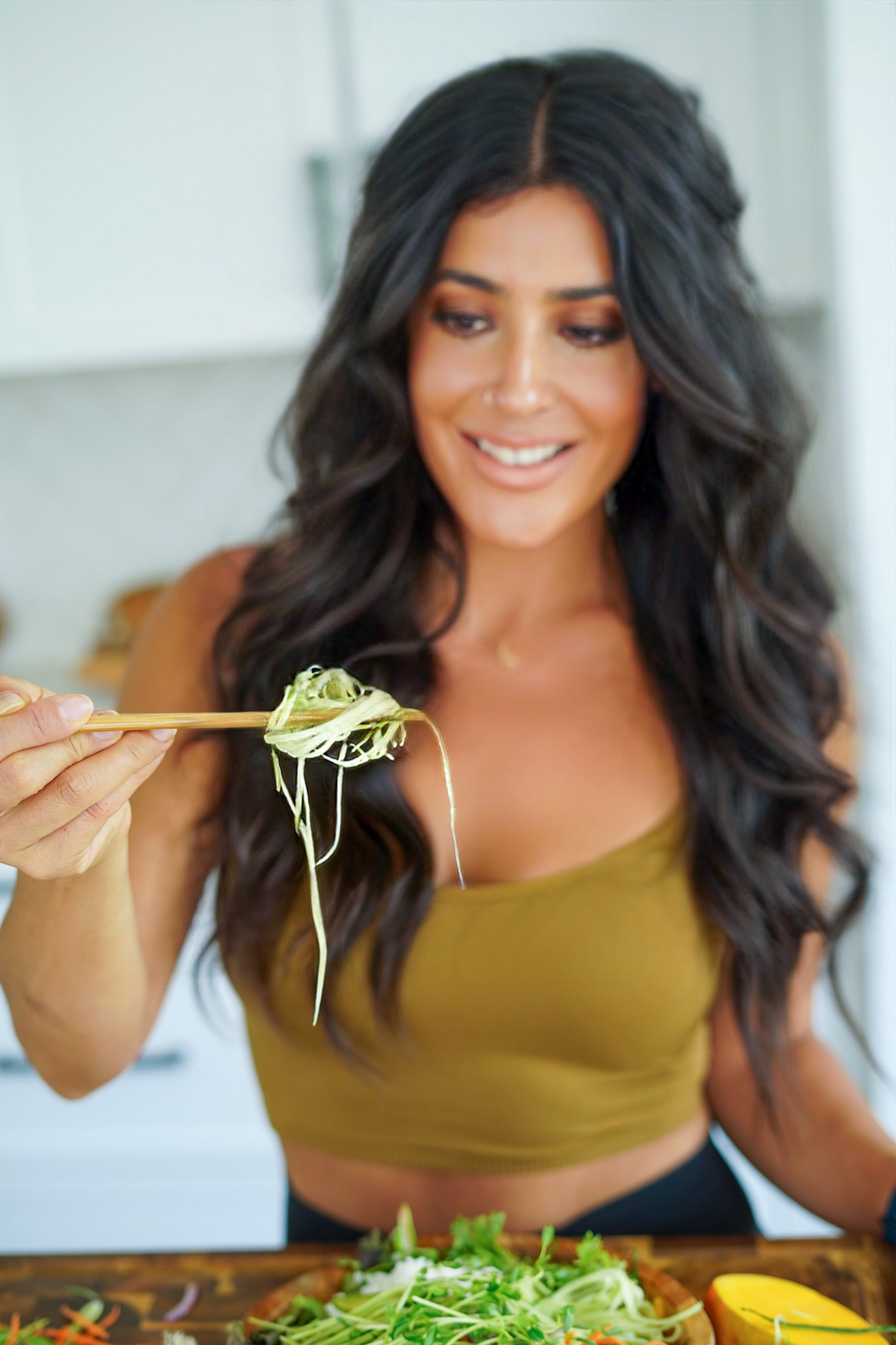
Why It Matters
So here is why it matters… If my hunger drive is driving me everyday to eat 4lbs of food and I choose to eat foods that are high in calorie density, the chance is that I’m going to at least take in the number of calories I need to maintain my weight, or go well over the amount of calories I need in a day making weight loss impossible and weight gain probable. If I eat 4 lbs a day of food and eat 900 cal/lb, 1400 cal/lb, 1800 cal/ lb, and 850 cal/ lb, then I’ve just consumed 4,950 cal in one day!!! My body only needs about 2,000 calories a day to maintain its weight! And this is why I was overweight for so many years. It wasn’t my hormones or my genetics, or even my lack of exercise. It was the calorie density of the foods I was eating. Now you see why calories per pound matter.
How Does Weight Loss Actually Work

So how does weight loss actually work? You have to create a calorie deficit. There’s just no way around it…. But if you find one let me know lol. I’ve been through every diet that promised results and I even tried many of the fad pills that promised weight loss and after years of broken promises, It came down to the good old calorie deficit. But I told myself I would never count calories again! And that is why calorie density is such a beautiful thing…It can really take you very far without ever having to track a single calorie.
Lets review the basics of calorie density for weight loss and then I’ll talk about how to further manipulate the principles of calorie density to continue to aid you in your weight loss journey.

Basics of Calorie Density For Weight Loss

- Remember to eat BELOW the 600 cal/ lb mark for easy weight loss
- Eliminate the use of oil for the quickest and biggest reduction in calories
- Use Nuts, Seeds, and Avocados Sparingly. (you can use avocados a lot more than nuts/seeds because their calorie density is only 750 cal/ lb vs 3000 cal/ lb
- Keep processed foods to a minimum and focus on vegetables, fruits, whole grains, and legumes.
Calorie Dilution

When researchers did all their studies they found that when people are below the 600 cal/ lb mark that they all lost weight and were able to get within a healthy weight range. However, they found that some individuals landed at the top of a healthy weight range, some in the middle, and some at the lower end of a healthy weight range. Now I know we all want to be at the lower end of our healthy weight ranges so that we look our perceived best in our swimwear, so here is how researchers helped the participants dilute their calories further so they could continue to see weight loss ….

Cut The Calories Not The Volume
This is where the real magic happens! I get so excited every time I have the opportunity to teach this because it is so simple and can be so life changing. It was for me!
Ok, let’s say you have this big beautiful bowl of pasta that has 700 calories. You then add ½ cup of marinara for 100 calories. The grand total for your meal is 800 calories. But let’s say you are trying to shed a few pounds before your vacation or the start of summer so you know you are going to need to cut back on the goodies. Traditional diets mean restriction, small portions, and lots of hunger and moodiness to follow. Just ask my husband, ask him how moody I got when I went low carb! But with calorie density you get to EAT THE SAME VOLUME OF FOOD FOR LESS CALORIES!! And here is how you do it…
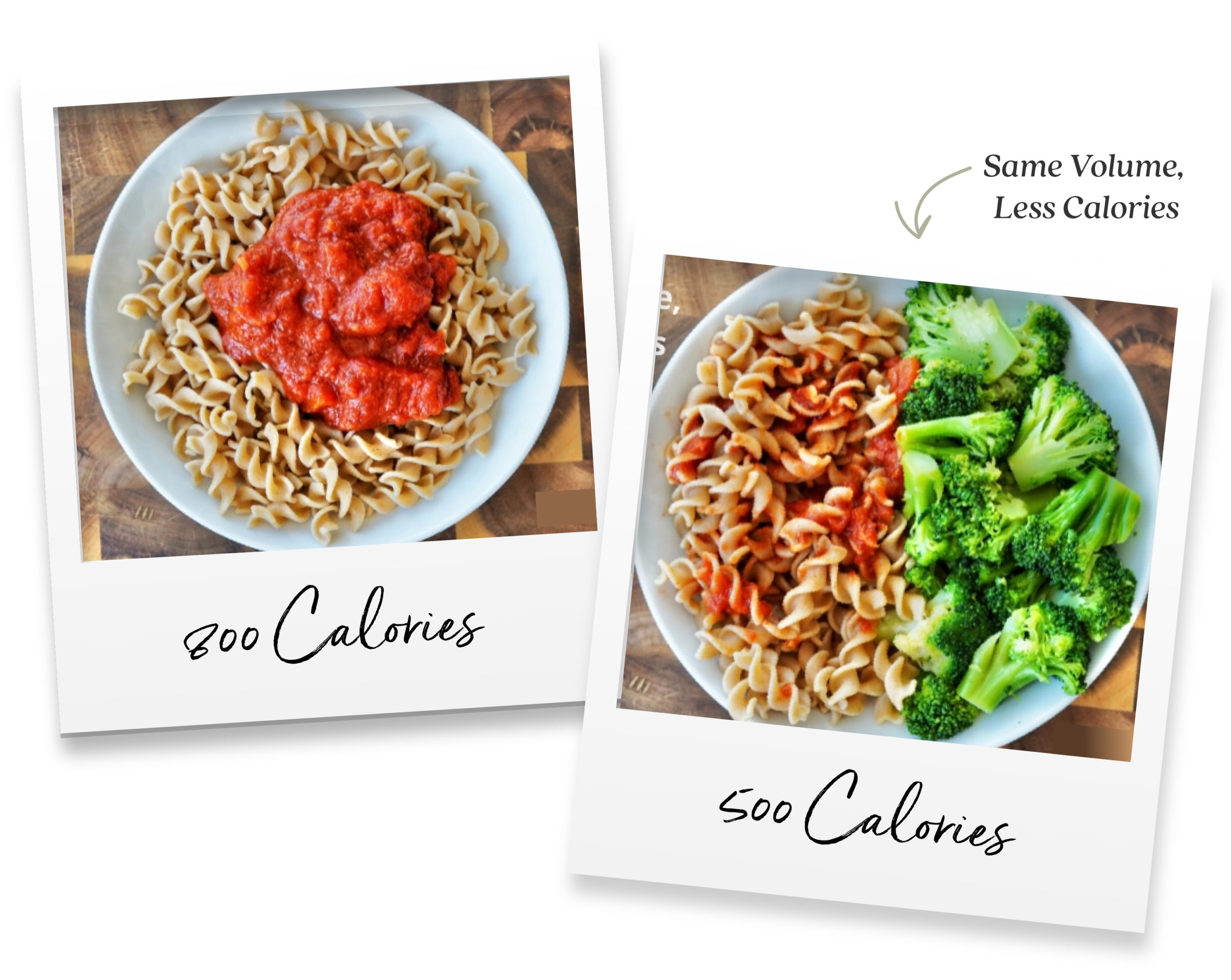
Back to our big bowl of pasta for 800 cal…To dilute the calories of this dish without reducing the amount of volume you get to eat, you simply remove half the pasta and replace it with a steamed non starchy vegetable and viola! Same volume, less calories! You now have 350 calories of pasta, 50 calories of pasta sauce, and 100 calories of broccoli for a grand total of 500 calories! You were able to cut the calories of your meal nearly in half without reducing the amount of food you get to eat. Plus the added bonus of all the nutrition and bulk of the broccoli to help keep you fuller longer. And this is the 50 / 50 plate.

The 50/50 Plate
The 50/ 50 plate is the single most beneficial tool you can use when it comes to calorie density and weight loss. If you are just starting your weight loss journey and have a significant amount of weight to lose then I would start with simply eating all the wholesome plant foods to be found below the 600 cal / lb mark. Once you hit a plateau and it seems like it’s going to hang around, then you know it’s time to start using the 50/50 plate. The 50/ 50 plate helped me lose the rest of the weight I needed to, and it’s still how I serve myself to this day and is what enables me to maintain my weight.
It’s simple to use and there’s no weighing or counting involved. All you have to do is fill half your plate with non starchy vegetables and the other side with starch, and always eat your non starchy veggies first.
Watch this playlist on my channel for lots of meal ideas for your 50/50 plate
But I Want Seconds
I hear all the time, but what if I’m still hungry and want seconds? Then go for it! Have seconds! Just serve yourself the same way and always eat your non starchy veggies first.
At First You May Feel Hungry and Full
When I first started using the 50/50 plate I felt so full but so hungry! I didn’t get it, how could I still be hungry if I was so full? Here’s what is happening…You are now taking in at least the same volume of food but in reality you end up eating more volume because whole unprocessed foods take up more space. They are full of fiber, water, and bulk. But here’s the thing, you are taking in way less calories that you used to but are still eating a large volume of food, it can take your body a week or two to figure this out…but hang in there, eat when you are hungry and your body will figure it out.
Soup Or Salad

To further dilute calories, preload your meal and start with a vegetable soup or salad BEFORE moving to your 50/50 plate.
Researchers took a group of participants and started their meal off with a soup or salad and then let them serve themselves dinner. What they found was that every individual ended up consuming significantly less calories than the day before when they didnt start with a soup or salad. All we are seeing here are the principles of calorie density at work. Fill up on the lowest calorie dense foods first and they help keep you full and satisfied while reducing the amount of more calorie dense food you take in.
And again if you are still hungry after your soup and 50/50 meal, go back for seconds and start with more soup. Chances are you will be too full to get to the more calorie dense side of you meal and all the fiber and bulk will help keep you full and you may end up eating less calories through the course of the day, and if you do this consistently then you will likely see weight loss.

A Whole Food Plant Based Diet Is The Best For Weight Loss
By simply looking at all the various calorie density charts out there, you will quickly realize that all the foods that are lowest in calorie density and highest in nutrition are plants. A whole food plant based diet that is low in fat, is naturally the diet lowest in calorie density. You can eat large volumes of these foods for less calories than animal food and any other processed foods. Not to mention that a plant based diet is sustainable, good for the environment, great for health, and very affordable if you stick to the produce aisles of the grocery store.
When Is Calorie Counting Helpful

So now lets talk about when calorie counting can be helpful…
I. When you’ve reached a plateau and can’t seem to budge it.
We all hit plateaus during weight loss, so we have to play with and adjust things in order to keep moving in the direction we want to. Sometimes it can be difficult to move through a plateau without an accurate snapshot of what is going on and that is where calorie tracking for a few days can help you see if you are still in a calorie deficit. If you are then you can rule that out as a possibility and move on to looking at your water intake, sleep habits, and stress / hormonal levels.
II. When you are eating according to calorie density and still can’t lose weight.
Sometimes we are doing all the right things but still can’t seem to get moving in the right direction and tracking calories for a few days will help you get a grasp on whether or not you are 1. In a calorie deficit, and 2. As consistent with that deficit as you think you are.
III. When you want to eat higher fat foods or processed foods but don’t want to slow your weight loss.
Sometimes you just want to eat some pizza and make a chocolate mug cake but you don’t want to sabotage your weight loss, this is another time that calorie tracking can be very helpful in helping you gain information so that you can stay on track. So if you have a day where you want to eat more calorie dense food, you can track your calories for the day to allow room for these foods while not going over so that you maintain your course.
The Pros and Cons Of Calorie Density and Calorie Counting
Calorie Density
Calorie Counting
Pros
Easy to do
No Counting
No Measuring
No Recording
Measured By Visual Volume
Cons
Can Be Difficult to Trouble Shoot a Plateau
Trial and Error to Find What is Enough Food/Too Much Food
Pros
Precise Calorie Intake
Controllable Calorie Intake
Cons
Tedious
Time Consuming
Can Feel Restrictive
Can Lead to an Unhealthy Relationship With Food
Can Be Unsustainable
Keep It Simple, Have Fun
So now you know more about the principles of calorie density and how to make them work for you. You also know the ways in which calorie tracking can aid you in your journey without having to be your journey. Make sure to subscribe to my youtube channel where I’m always posting meal plan videos and tips and tricks to help you along. As always, keep it simple and have fun! And always always keep this journey about health and not just about the skinny. I love you guys, and can’t wait to hear how you do!
Love,
Kiki


I’m a momma of two beautiful and adventurous kids, and a wife to an amazing and supportive man. I’ve always been a nutrition conscious, nature loving soul. Finding my way to a whole food plant-based lifestyle has been the full expression of who I am.
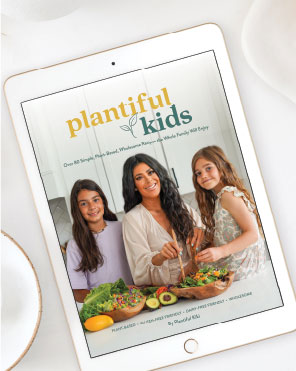
GET THE WHOLE FAMILY INVOLVED!
PLANTIFULKIDS
EBOOK
AVAILABLE NOW
Related Posts
Nama: The Ultimate Juicing Solution for Busy Plant Enthusiasts
nerdymind2025-06-23T22:04:29-06:00April 2, 2024|
Positive Self-Talk Methods When Eating Plantifully Lean
nerdymind2024-03-14T10:44:40-06:00February 21, 2024|
How To Make New Year’s Resolutions Stick
Brillity Digital2024-02-28T07:28:21-07:00December 17, 2021|
How to Enjoy The Holidays and Not Gain Weight
Brillity Digital2024-02-28T07:29:01-07:00December 10, 2021|


I’m a momma of two beautiful and adventurous kids, and a wife to an amazing and supportive man. I’ve always been a nutrition conscious, nature loving soul. Finding my way to a whole food plant-based lifestyle has been the full expression of who I am.

GET THE WHOLE FAMILY INVOLVED!
PLANTIFULKIDS
EBOOK
AVAILABLE NOW





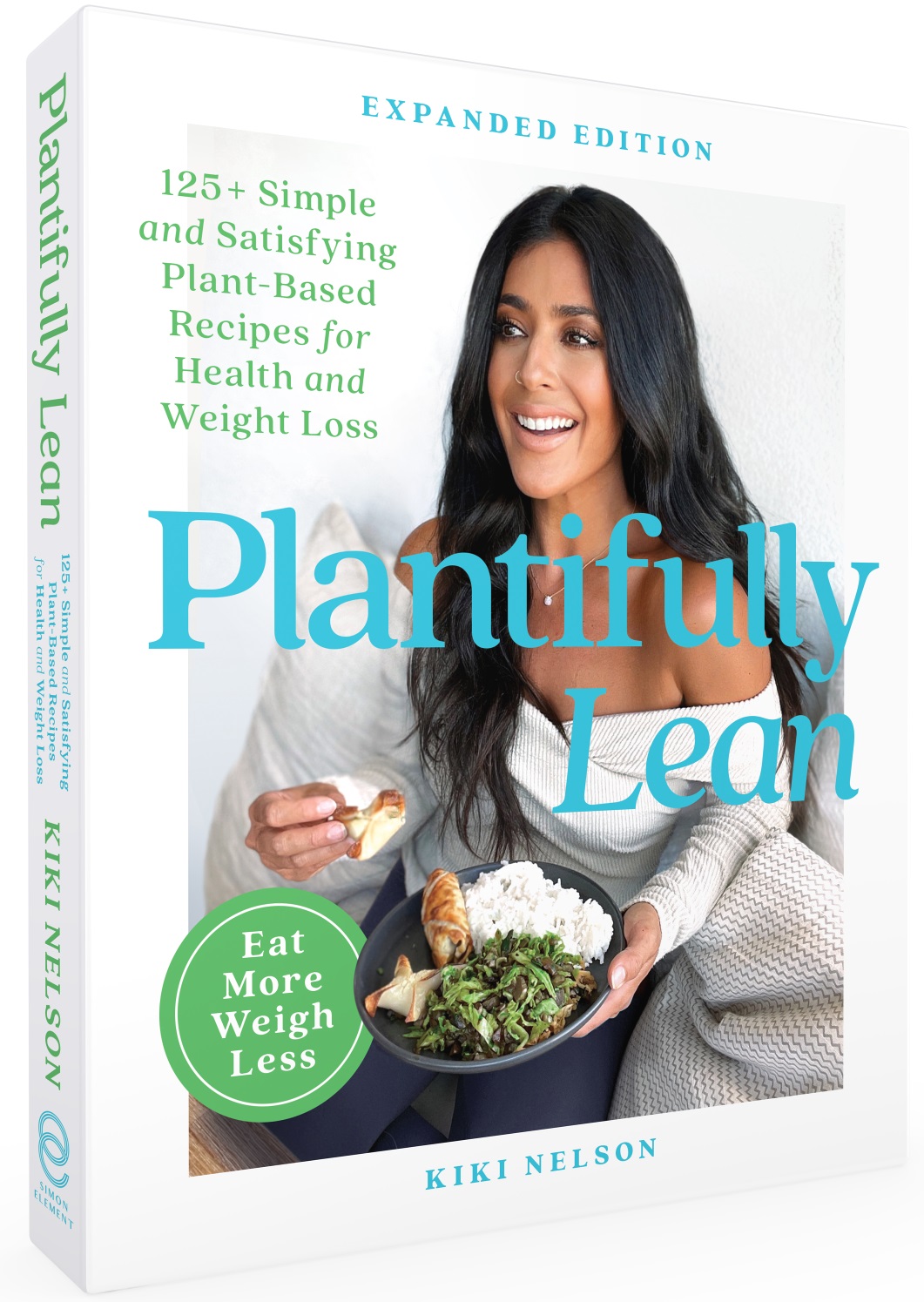

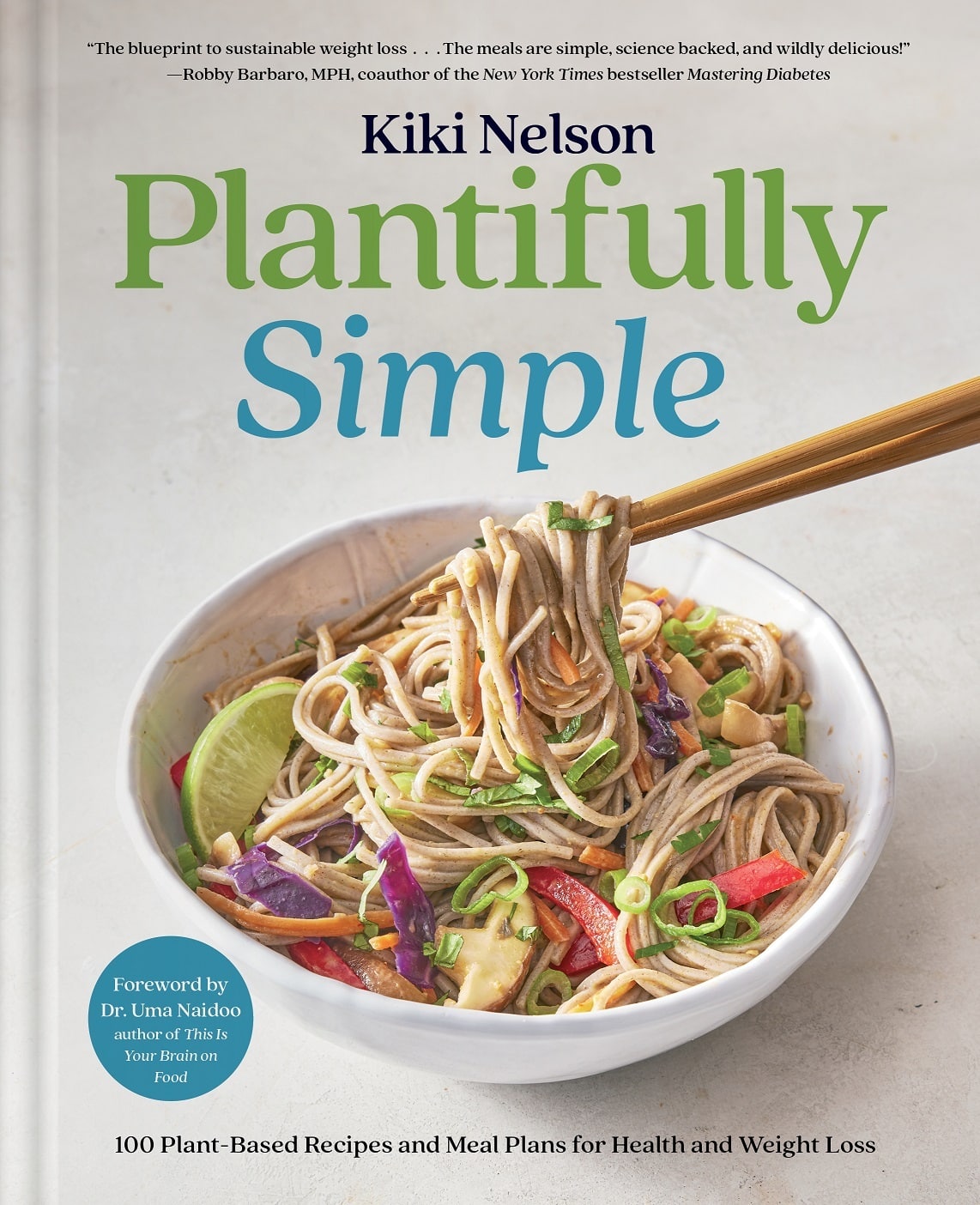


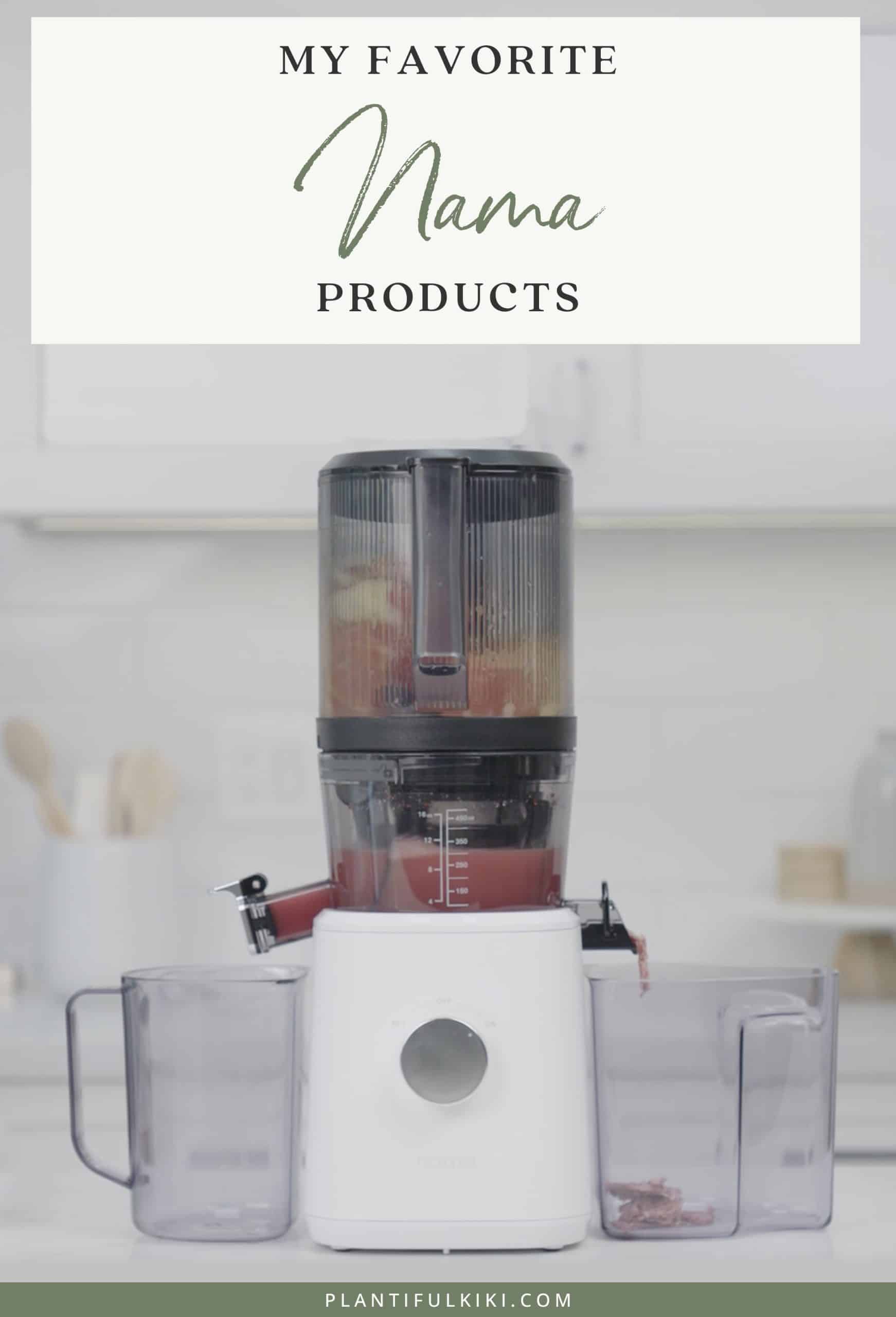







Is there a reason you dont use tofu or tempeh in any of your cooking. I am fairly new to plant based. I have trouble with breakfast (dont like oatmeal) and found make a tofu scramble with spinach, mushrooms and tomatoes makes me feel satisfied. Also do you believe in protein powders. I am 66 and other than walking do not exercise much…(knee surgery) since following you and high carb hanna I am down 30lbs in 7 months and feel great. Thank you
The only reason I don’t use tofu or tempeh much is because I don’t like it:( Ive tried and tried and I just can’t get over the taste lol. If you enjoy your tofu scramble then definitely keep enjoying it! as far as protein powders, I do not personally use them. Many of the plant based doctors/ experts recommend against using them as it can be hard on the liver and kidneys. You can check out the exam room podcast, they have several episodes on protein where experts like dr. Neal Barnard speak to the issue:). Congratulations on losing 30lbs!!!! you have done amazing!!!
Where do you get your tops? Always so cute
Thank you!! The cross over athletic tops are actually from amazon, otherwise I love collecting unique tops from little mountain boutiques:)
I just started watching some of your interviews/videos and you are really a great example. You look healthy and your food looks fun. I I have been trying to go plant based but just haven’t made it. I have 100 pounds to lose so I will try again following you. Thank you for sharing what you have learned. Wish me luck!
I have read through your blog and do need to educate myself on the 50/50 strategy and the science behind the food weight intake (that part makes sense from experience) but what are you doing for protein? I understand the there is protein in the foods you eat but it doesn’t seem realistic amount for someone with as much muscle definition. I’m not hating but curious,
Im sending you my very best wishes!! you can totally do it! just start slow if you need to and makeover your breakfasts. Once you’ve been having plant based breakfasts consistently and it’s a habit, then makeover your lunches and so on:)
Hi Kiki! Can you comment on eggs? I haven’t seen them mentioned anywhere. Also, does the 50/50 plate apply to all meals or just dinner?
Eggs are not part of a plant based diet. They are not recommended by plant based doctors for many reasons. 50/50 would be for all meals if you are trying to lose weight. You can always adjust this if you are happy with your weight loss progress doing it at dinner only.
Do you ever count macros? If so, agar would be a good range to hit for weight loss?
Hi Kiki,
I love your channel after just recently finding it. I started on a plant based journey Jan 5th of this year due to very similar health issues you describe. This way of eating / living has also made a huge difference for me in being down 30lbs already and all of my issues disappearing one by one. I love the easy to understand / straightforward information you provide as it’s greatly appreciated and helpful to say the least. I do have one question for you…with regards to Beans, lentils etc., I just turned 50 and have really not eaten these until now. I’m having a hard time eating them as it’s a texture thing for me…lol. Do you have any suggestions on maybe which beans to try and how to prepare them?
Thanks so much Kiki, keep being you…the content is amazing.
Cheers,
Rick